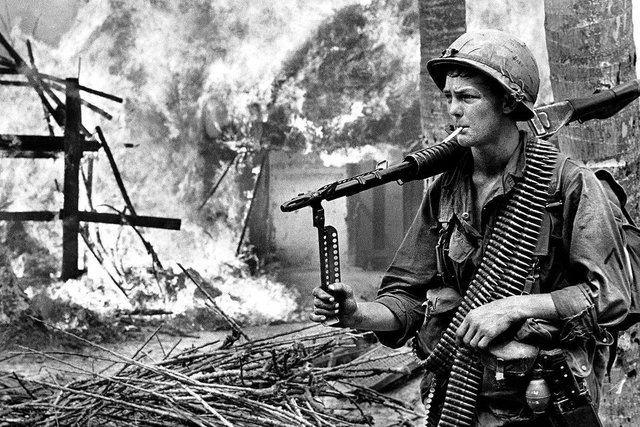1966 - Escalation in Vietnam War
More American troops arrive in Vietnam, although it becomes clear that US strategy is not suited to deal with a determined enemy, while protests increase at home.

It was the year of the reality check, when Americans and their own government began to realize just what they faced in Vietnam — a resourceful and tenacious enemy, quarrelsome allies and an Asian society whose complexity they could barely understand. Back home in 1966, the U.S. administration struggled to sell the war as a noble and necessary sacrifice to stop global communism and save a weak, backward people from an evil aggressor seeking to enslave them. By the end of the year, however, a vigorous anti-war movement was emerging on American university campuses. Prominent voices for and against the war were openly questioning President Lyndon B. Johnson’s strategy.
At the start of 1966, the number of American service members in South Vietnam had risen to 184,314. They joined about 514,000 South Vietnamese troops facing a combined force of an estimated 280,000 North Vietnamese regulars and Viet Cong guerrillas. But numbers didn’t tell the full story. Despite their numerical weakness, the North Vietnamese were able to control the tempo - fighting aggressively where they thought they could win and disappearing into the jungles and across the border with Laos and Cambodia when they decided they could not. The Communists exploited deep divisions within South Vietnamese society, making it difficult for the U.S. to capitalize its huge military superiority.
At the end of January, U.S., South Korean and South Vietnamese troops began the biggest “search and destroy” mission to date against communist forces threatening Highway One, a major north-south supply route in coastal Binh Dinh province about 400 miles north of Saigon. The operation provided some limited tactical success but failed to achieve major victories because the communists often eluded fights they knew they couldn’t win
When the communists thought they could win, they didn’t back down from a fight. On March 9, the North Vietnamese stormed a small Special Forces and South Vietnamese camp in the A Shau Valley, overrunning the camp after two days of bitter, often hand-to-hand fighting. U.S. helicopters rescued survivors after the 17-man Special Forces team suffered 100 percent casualties, five dead and 12 wounded. The U.S. estimated about half the North Vietnamese attackers were killed or wounded. But the North Vietnamese held the camp and used it as a supply and staging area for the Tet Offensive two years later.
In July, U.S. and South Korean troops blocked an attempt by North Vietnamese forces to infiltrate from Cambodia. An Australian-led force won a significant tactical victory in a battle in a rubber plantation near Long Tan in August. Despite suffering heavy casualties, the North Vietnamese showed no sign they were about to quit. In October, Defense Secretary Robert McNamara wrote in a memo that the communists were losing 60,000 fighters a year “yet there is no sign of an impending break in enemy morale and it appears that he can replace his losses by infiltration from North Vietnam and recruitment in South Vietnam.”
“We control little, if any, more of the population,” McNamara wrote. “In the countryside, the enemy almost completely controls the night.”
Johnson faced criticism from all sides. On college campuses, anti-war groups were growing, and McNamara was confronted by a hostile crowd of students during a visit to Harvard. Heavyweight boxing champion Muhammad Ali refused to accept a draft notice to protest the war. Polls showed support for the war was declining as large protests occurred in Washington, New York and California.
On the other side, former Vice President Richard Nixon called for increasing the number of U.S. troops in South Vietnam to 500,000 and spreading the bombing campaign to Hanoi itself. Former President Dwight D. Eisenhower, the great hero of World War II, supported Nixon’s criticism, accusing Johnson of “hesitation, indecision and even timidity” in the war. Even in the ranks, senior officers began questioning whether Westmoreland’s strategy of large formation “search and destroy” missions, aimed at exhausting the communists through a war of attrition, would work.
Johnson and his international partners offered in October to withdraw all troops within six months if the North Vietnamese left the south. The offer was rejected. By the end of 1966, U.S. troop strength in South Vietnam had risen to more than 385,000 — more than double the number when the year began. More than 5,000 U.S. service members had been killed, while more than 30,000 had been wounded. To meet the demands for more troops, the Selective Service System drafted more than 382,000 men in 1966, compared to only 82,000 four years before. The dramatic increase prompted more Americans to begin questioning the war.
For more images from the war in 1966 check out History0x